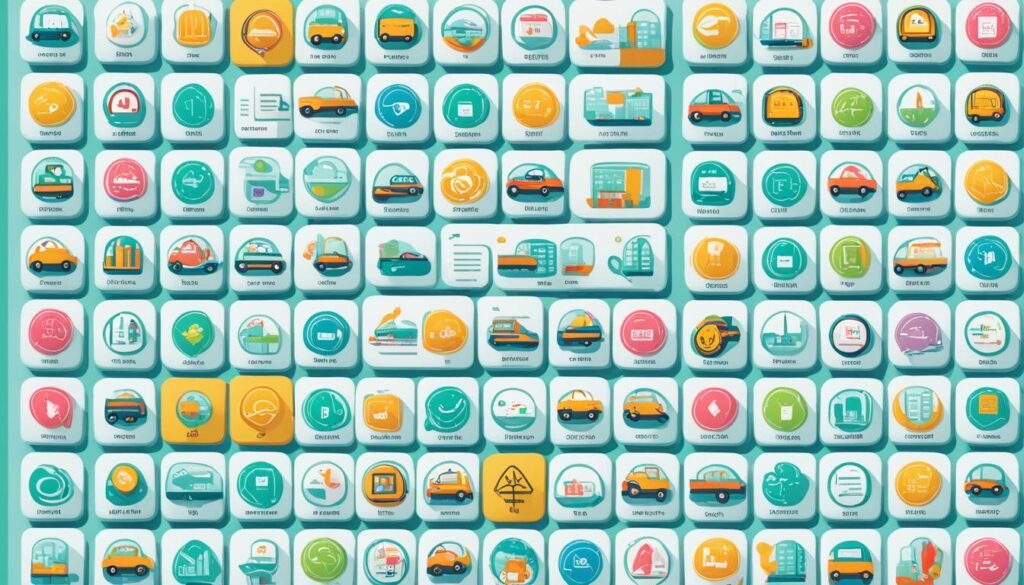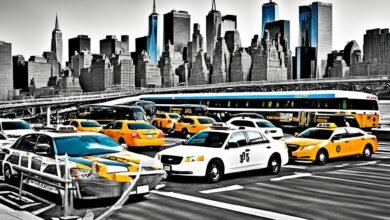Table of Contents
Exploring Seoul, South Korea, is exciting. Knowing how to use public transport is key. You can use Seoul’s subway system, bus routes, and transportation apps to move easily. But, what’s the best way to use these tools for a smooth journey around the city?
Understanding Seoul’s public transport is the first step. The city’s Seoul Metro and bus routes are easy to use. Thanks to transportation apps, getting from one place to another is simpler. So, let’s learn how to travel around Seoul like a local.
Understanding Seoul’s Extensive Public Transportation Network
The Seoul public transportation system is super efficient. It includes the Seoul Metro and many buses, making it easy to get around. No matter if you’re new or know the city well, using this network helps you explore Seoul fully.
Overview of the Seoul Metro System
The Seoul Metro has 22 lines and 302 stations, covering the city well. You can start your trip for just ₩1400 if you use a transport pass. Plus, you get up to four free transfers to other lines or buses within 30 minutes.
Color-coded Bus Routes
Seoul’s bus network is large and easy to understand because it’s color-coded. Green and blue buses run across the city, while red buses go further to outer areas. Yellow buses visit popular tourist sites, and small green local buses (maeul) connect smaller neighborhoods.
Integration of Transportation Cards
You can choose from several cards like T-money, NAMANE, and Cashbee to move around Seoul. These cards offer savings and make transferring between different transportation modes free within a time frame.
Navigating the Seoul Metro
The Seoul Metro network is easy to use. It has many English signs and messages in stations. You will find signs in Korean, English, Chinese, and Japanese at every station. This makes it simple to move around. The screens tell you when trains are coming and leaving. Plus, exit signs show you where landmarks are. This helps you find your way in the city.
Fares and Transfers
One ride on the Seoul Metro starts at ₩1400 with a card. You can change subways or buses for free within 30 minutes, up to four times. This system lets you travel around the city easily. It’s a smooth way to switch between different forms of transport.
Metro Etiquette and Accessibility
It’s key to know the rules when riding the Seoul Metro. People usually wait in line before getting on the train. They often keep the front seats free for those who need them most. This includes the elderly, pregnant women, and people with special needs. Almost all stations are easy to get around for everyone. They have things like elevators, Braille signs, and special seats. This makes sure that everyone can have a pleasant trip.
Mastering the Bus System
Buses in Seoul might take a bit more time than the Metro. They come in handy for traveling to quieter areas or when the Metro route is a bit tangled. The Seoul bus network has many buses and routes to get you around easily.
Types of Buses and Routes
In Seoul, you’ll find five different types of buses, each with its own color. Green and blue buses run across the city. The red buses go from Seoul to the suburbs. Yellow buses run around top sights. Then, there are green local buses (maeul) that focus on a specific area. With the Seoul bus route system, moving through the city and linking up with the Metro is simple.
Bus Stop Information and Signage
Finding your way at Seoul bus stops is easy. They show bus routes in Korean and English. Plus, many stops have screens that tell you when the next bus is coming and if it’s full, which is a big help.
Paying for Bus Rides
You can pay for your bus ride in Seoul with cards like T-money, NAMANE, or Cashbee. These cards let you switch between buses or from bus to Metro within 30 minutes, up to four times, without extra charge. Remember, it’s polite to give up your seat for those who need it more, but on buses, it’s not always enforced as strongly as on the Metro.
Using Transportation Cards
The T-money card is widely used in Seoul for travel. It lets you pay for buses, subways, taxis, and even at some shops. This transportation card gives discounts to regular users and allows free switching between travel options within a limited time. Additionally, many T-money cards have cool designs, making them great souvenirs for Seoul visitors.
Other Transportation Card Options
Besides the T-money card, there are other choices like NAMANE and Cashbee in Seoul. These transportation cards work the same way and help you save money while moving around the city. Picking the right transportation card can simplify your journey through Seoul‘s vast public transport system.
Hailing Taxis in Seoul
When you’re in Seoul’s lively streets, getting a taxi can be a smart choice. This is especially true if you’re new and finding public transport confusing. There’s a wide range of taxis available, fitting various budgets and preferences.
Taxi Types and Fares
The most typical taxis in Seoul are the mid-size sedans. They start at ₩4,800, with an extra ₩100 for every eighth of a mile. For those with lots of friends or luggage, deluxe or jumbo taxis are better. These can carry up to 8 people but charge more for their services.
No matter the kind of taxi, you can pay in cash, card, or use your T-money card.
Ride-hailing Apps and Services
Seoul isn’t just about flagging down taxis. You can also use apps like Kakao T to call a driver to your spot. But note, many may need a local phone number to work. If that’s not an option, the International Taxi Service has English-speaking drivers to make getting around easier.
Exploring Seoul by Bicycle
Getting around Seoul can be more than using its great public transit. Visitors can see the city by bike too. This is thanks to a wide range of cycling routes and trails that Seoul has developed.
Seoul Public Bike (Ttareungi) System
The Seoul public bike system, called Ttareungi, is a top pick for biking around the city. It has bright white and green bikes available at over 1,500 spots in Seoul. To use them, folks can sign up online and manage their rides with the Seoul Bike app. This way, visitors can see Seoul in a flexible and fun way.
Cycling Routes and Trails
Cycling in the city might mean sharing with walkers, but there are special paths too. These cycling routes and trails make riding smoother and safer. For example, the Hangang River Cycling Trail is a beautiful choice. It goes along the Han River and shows off amazing city views. When cycling, remember to walk your bike at crosswalks, it’s a rule in Seoul, even if it’s not checked often.

Walking in Seoul
Walking in Seoul is a great way to see the city. It’s dense, so you can see a lot by walking. You’ll find many shops, restaurants, and sights close to each other. This lets you discover hidden places while enjoying a slow walk.
Advantages of Exploring on Foot
From Gyeongbokgung Palace to Changdeokgung Palace, it’s only a 1.3km walk. This path is full of cafes, shops, and history. Walking lets you really get into Seoul‘s lively vibe and experience its culture slowly.
Pedestrian-friendly Neighborhoods
Seoul has many areas perfect for walking. Places like the Bukchon Hanok Village and Insadong are beautiful for a stroll. You won’t face much traffic as you explore the shops and places to eat.
Transportation Apps and Resources
Navigating Seoul’s broad public transit system is now easier, thanks to many mobile apps and online tools. These resources give you up-to-the-minute details on routes, schedules, and change points. They also share tips to make your travel in the city better.
Mobile Apps for Route Planning
Apps like Seoul Subway, Metroid Korea Subway Info, and Subway Navigation by Kakao are a must for anyone exploring Seoul. They boast detailed maps, live updates on schedules, and tips from other riders. Using them, sorting out your Seoul travel needs is a piece of cake.
Online Resources and Guides
Besides apps, the web is packed with information to help you around Seoul. Explore interactive maps, thorough guides, and info-rich sites to get the big picture on public transit. These digital tools are gold for both newbies and Seoul experts, making the most of the city’s varied transportation options.

Accessible Transportation Options
Seoul’s public transportation is easy to use for people with disabilities. It helps them get around the city smoothly. Many subway stations have elevators, Braille tiles, and seats for those who need them the most.
Accessibility Features on Public Transportation
The Seoul Metro has trains and buses that are disability-friendly. Almost all subway stations have elevators, making it simple to reach the platforms. For those who can’t see, there are Braille tiles and announcements to assist. And, there’s special seating for the elderly, pregnant women, and those with disabilities.
Resources for Travelers with Disabilities
Visit the Seoul Danurim website for details on accessible travel. They help with tips on taxis, tours, and more. Lonely Planet also has guides for disabled visitors to Seoul, packed with useful info.




